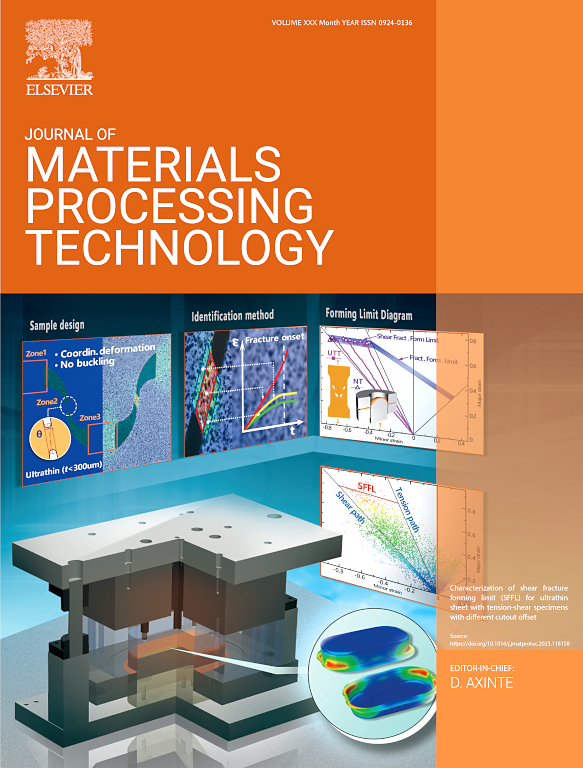Highly efficient damage recovery in MgO: Insights from plasma-enabled atomic-scale reconstruction
IF 6.7
2区 材料科学
Q1 ENGINEERING, INDUSTRIAL
Journal of Materials Processing Technology
Pub Date : 2025-05-06
DOI:10.1016/j.jmatprotec.2025.118886
引用次数: 0
Abstract
Single-crystal MgO has been extensively used in electronic devices, optical windows, and thin-film growth. However, its high hardness and brittleness pose significant challenges to efficiently obtaining a smooth and low-damage surface through conventional chemical mechanical polishing and high-temperature annealing, limiting its further industrial applications. Here, we propose a plasma-enabled atomic-scale reconstruction (PEAR) strategy to overcome these bottlenecks, enabling rapid damage recovery and achieving atomic-scale smoothness in single-crystal MgO. The damage recovery process exhibits anisotropic material flow, governed by the interplay between crystal structure and damage characteristics—a previously unreported mechanism in PEAR. Additionally, by inducing atoms’ migration and rebonding within the damaged region according to crystal properties, PEAR not only recovers micro-scale grooves with depths of 200–300 nm within 25 min of Ar plasma irradiation, but also enhances the surface and crystal quality of MgO, resulting in an atomic-scale smooth surface with an Sa roughness of less than 0.1 nm (1 μm × 1 μm). Moreover, PEAR demonstrates crystal plane-agnostic repairability, successfully recovering laser-induced grooves on the (100), (110) and (111) crystal planes, highlighting its broad applicability in surface smoothing. This universal recovery behavior, achieved despite the crystallographic anisotropy of MgO, suggests a paradigm shift in atomic-scale processing of hard brittle oxides. Our findings establish PEAR as a transformative methodology for surface engineering of wide-bandgap single-crystal transparent materials requiring atomic-scale precision.
MgO的高效损伤恢复:来自等离子体原子尺度重建的见解
单晶MgO已广泛应用于电子器件、光学窗口和薄膜生长。然而,它的高硬度和高脆性给传统的化学机械抛光和高温退火获得光滑和低损伤表面带来了巨大的挑战,限制了其进一步的工业应用。在这里,我们提出了一种等离子体支持的原子尺度重建(PEAR)策略来克服这些瓶颈,实现单晶MgO的快速损伤恢复和原子尺度平滑。损伤恢复过程表现出各向异性的物质流动,由晶体结构和损伤特性之间的相互作用所控制,这是先前在PEAR中未报道的机制。此外,PEAR根据晶体性质诱导原子在损伤区域内的迁移和重键,不仅在Ar等离子体辐照25 min内恢复了深度为200-300 nm的微尺度凹槽,而且还提高了MgO的表面和晶体质量,获得了Sa粗糙度小于0.1 nm (1 μm × 1 μm)的原子尺度光滑表面。此外,PEAR证明了晶体平面不可知的可修复性,成功地恢复了(100)、(110)和(111)晶体平面上的激光诱导凹槽,突出了其在表面平滑方面的广泛适用性。尽管MgO具有晶体各向异性,但这种普遍的恢复行为表明,在原子尺度上处理硬脆氧化物的范式发生了转变。我们的研究结果确立了PEAR作为需要原子尺度精度的宽带隙单晶透明材料表面工程的变革性方法。
本文章由计算机程序翻译,如有差异,请以英文原文为准。
求助全文
约1分钟内获得全文
求助全文
来源期刊

Journal of Materials Processing Technology
工程技术-材料科学:综合
CiteScore
12.60
自引率
4.80%
发文量
403
审稿时长
29 days
期刊介绍:
The Journal of Materials Processing Technology covers the processing techniques used in manufacturing components from metals and other materials. The journal aims to publish full research papers of original, significant and rigorous work and so to contribute to increased production efficiency and improved component performance.
Areas of interest to the journal include:
• Casting, forming and machining
• Additive processing and joining technologies
• The evolution of material properties under the specific conditions met in manufacturing processes
• Surface engineering when it relates specifically to a manufacturing process
• Design and behavior of equipment and tools.
 求助内容:
求助内容: 应助结果提醒方式:
应助结果提醒方式:


